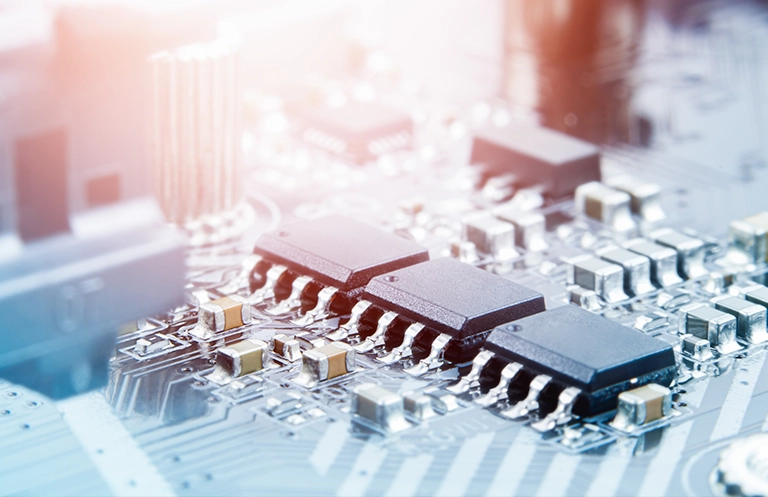The design specifications are often tweaked to make them an automotive grade and let them easily handle the vehicle’s temperature and vibration levels. Due to the intricacies of the operating environment and use cases, automotive electronics have to be more electromagnetic interference resistant than pocket devices. However, silicon is just a part of the solution, it being a piece of highly engineered sand sans supporting software.
The lines of code quickly multiply in modern vehicles as hundreds of Electronic Control Units (ECUs) regulate everything from fuel supply to battery charge management to climate control. Traditionally, each ECU has its set of chips and peripheral devices, all of which operate on their driver code.
The Automotive Industry is increasingly reliant on data due to the integration of multiple sensors and camera modules. In autonomous vehicles, data, when combined with software and advanced computing is transformed into decisions. As autonomous vehicle technologies advance, the data generated within the vehicle continues to grow exponentially. The question is, how much data can the connected vehicles produce?
There are different levels of autonomy in vehicles, and the most advanced level is the fully autonomous vehicle.
“According to a report by Cisco, the monthly mobile data traffic per smartphone in North America is expected to rise to 50GB (1.6GB per day) by the end of 2024. With the connected cars transferring 8GB per day by 2023, the data volume from vehicles will rapidly outstrip that of the smartphones.”
The sensors and switches in the vehicles collect data related to the temperature, voltage, acceleration at different angles, pressure, braking, yawing and rolling of the vehicle, steering angle, and many other signals. All these systems generate huge data that require sophisticated electronic support, including high-speed data nodes, links, cables, and assemblies.
The Controller Area Network (CAN) is used when an ECU requires a signal from a sensor that is connected to another ECU. CAN allows the data to constantly circulate in the vehicle. Each device continuously transmits its sensor and programming data. At any given time, up to 2,000 signals are found floating across the network. As a result, businesses are increasingly relying on modern hardware and software platforms to support high-speed communication and massive data transmission.
Some of the advanced hardware and software platforms used in the automotive industry are listed below:
Advanced Hardware Platforms in the Automotive Industry
NXP S32
NXP has launched a new processor range that keeps the company competitive in the new mobility environment by providing better efficiency, reducing energy consumption, and minimizing software development efforts.
What is the purpose of the S32 automotive processing platform?
Vehicles are expected to become more electrified, connected, and automated than ever before in the coming years, and some fundamental changes are anticipated in the automotive electronic architecture. As more data is created by the sensors, is exported to the cloud, and is consumed through various services, vehicles now require new computational capabilities. To cater to this requirement, NXP has developed the S32 processing platform.
S32 microcontrollers and microprocessors are designed to combine performance and power efficiency for automotive and industrial applications. A series of scalable 32-bit MCUs have been developed for the automotive body, zone control, and electrification applications to tackle the current and future connectivity, security, and safety challenges.
- Provides 10 times better performance than the currently available platforms.
- Lowers the software development lifecycle by 90% across application domains and above 40% overall.
- Delivers all-new levels of automotive safety and Over-the-Air (OTA)
What are the benefits of using the S32 automotive processing platform?
The S32 platform helps maintain multiple firmware versions. By allowing memory flexibility, the platform enables the software to roll back to its good version, hence, it lowers the risk of installation failure. It is used to process service-oriented gateway applications, safety co-processors, and domain controllers.
For the S32 chip line-up, the company leverages its design commonality to provide scalable software solutions that complement the hardware. According to NXP, engineers can reuse up to 90% of the low-level code across each ECU by using the S32 chips in the vehicle.
Besides saving on time, reusability means that most of the testing and validation, including security testing, that has already been done on one application, can be applied on other applications.
The company claims that the new chip is up to ten times faster than today’s fastest processors. If the processors are power effective, there is no reason that these high-end chips cannot be combined with Intel FPGAs, Nvidia GPUs, or one of Mobileye’s EyeQ4/5 chips to handle AI functionality in an ECU.
Why the NXP S32 Architecture was required?
NXP S32 has a scalable architecture that can handle a wide range of performance levels, from a low-power core Arm® Cortex®-M to high-performance Cortex-A. Having a scalable option for a processor’s core enhances the product’s life cycle while also making the feature enhancements and reductions easier. Also, all these Arm cores- M, R, and A come with the highest level of functional safety capabilities i.e Automotive Safety Integrity Level (ASIL) D. Over-the-Air Updates – The S32 platform, through a secure gateway and a common domain architecture, offers zero-downtime, and the OTA functionality with full roll-back options to all the supported vehicle domains.
Each microcontroller has application-specific IP that provides customized hardware support for the key domain requirements such as secure gateway, powertrain, radar, and motor control.
Artificial Intelligence – The S32 platform supports a variety of AI accelerators aimed at Advanced Driver-Assistance System (ADAS) applications. It also speeds up the algorithms of the radar, the vision, and the sensor fusion, that aid object detection, and classification.
NXP S32 provides processing speed with 10,000+ DIMPS, connectivity with gigabit ethernet, OTA updates, predictive maintenance, end-to-end security, and functional safety, ASIL B -> ASIL D.
Snapdragon Automotive Cockpit (Qualcomm)
Qualcomm launched a new auto platform – Snapdragon Automotive Cockpit that leverages artificial intelligence for in-vehicle virtual assistance, safety, and driver interfaces. The company, through its collaboration with Amazon, has integrated the Alexa Automotive Software Development Kit (SDK) into the new platform to create a customized version of Alexa for an in-vehicle intelligent assistant.
The Original Equipment Manufacturers (OEMs) can create a customized experience with the SDK, through the custom wake words, voices, and other features. Just like the Snapdragon Telematics framework, Alexa’s functionality can also be supported and updated using Qualcomm’s vehicle-to-Cloud service.
NVIDIA DRIVE
NVIDIA DRIVE, an Autonomous Vehicle Development Platform includes:
– DRIVE AGX (In-Vehicle AI Computer): This Developer Kit includes all hardware, software, and sample applications required to build production-ready autonomous vehicles (AV).
– DRIVE Hyperion (Car Reference Architecture): It is a reference architecture for NVIDIA’s Level 2+ autonomy solution, which comprises a full sensor suite, AI computing platform, and the full software stack for autonomous driving, driver control, and visualization. The kit can be installed in a test vehicle that allows the AV developers to test, analyze, and validate the AV technology.
– DRIVE Sim (End to End simulation platform): It is a complete simulation platform designed from the ground up to run large-scale, physically accurate multi-sensor simulations. This free, scalable, and modular platform supports AV development and validation from concept to implementation, boosts developer efficiency and speeds up the time to market.
These platforms also provide rich Software Developer Kits (SDKs) to help accelerate the production of autonomous vehicles (AVs).
Automotive Software Platforms and their key information
1. Control Program and Operating Systems
All automotive ECUs need a control program to manage several other programs that control the hardware components and applications of each ECU. The Automotive Open System Architecture (AUTOSAR) is one such platform that has been built by the automotive industry collaboration. AUTOSAR is a layered software architecture for ECU applications that uses standard Application Programming Interfaces (APIs). It also has a hardware-agnostic interface to the majority of automotive microprocessor architectures. Many organizations follow AUTOSAR, the automotive industry’s most popular compliance, for their ECU software/firmware development.
However, AUTOSAR cannot manage the ECUs that include massive, complicated software codes, such as infotainment systems, telematics, and ADAS applications. This led to the development of OS, a high-tech platform that has significantly impacted the automotive industry. Some safety-critical ECUs require an operating system with certifications like ISO 26262that no Linux versions presently have. So, QNX, Green Hills, and similar operating systems with safety certification are preferred over Linux.
A typical Operating System platform requires abundant “middleware”, to perform various functions. Middleware, often referred to as “software glue”, provides services to the applications that the operating system as a whole does not. Some examples of middleware are the utility software and drivers that allow the hardware to interface with the OS.
2. Hypervisor OS
A hypervisor, also known as a Virtual Machine Monitor or VMM, is a type of hardware virtualization that enables many guests operating systems to run on a single host system concurrently. The guest OS emulates its processor, memory, and other hardware resources, by using the host computer’s hardware. The computer can share its memory, thanks to the hypervisor program installed on it.
The following are the two types of hypervisors:
Type 1 hypervisor functions as a light operating system that runs directly on the host’s hardware, whereas type 2 works as a software overlay on top of an operating system.
The best two examples that show the advantages of a Hypervisor are –
First, the backup monitor is a safety-critical system that is now a must for all new vehicles sold in the United States. Second, the infotainment system monitor is sufficient for a backup display, however, it cannot be used with a Linux OS as it lacks safety-critical clearance.
The alternative is to use a hypervisor that combines Linux with QNX, Green Hills OS, or any other safety-certified operating system. Another scenario where a hypervisor can be useful is the convergence of the instrument cluster and the infotainment system.
3. Telematics Systems
The Telematics systems include an embedded software platform that communicates with a SaaS platform to deliver the telematics services. There are multiple telematics solutions in the market which run on different operating systems, but QNX is one of the prominent choices for OS in telematics system.
Most of the top Tier 1 suppliers in the market provide telematics software and hardware systems as it is one of the key elements of vehicle dynamics which provides important insights on navigation, driving analysis, engine health monitoring, and many more.
4. Infotainment Systems
High-end infotainment systems are the most complex automotive software systems, which are currently mass-produced. Typical to such systems are the complex display systems with audio entertainment, navigation systems, and numerous applications. When available, there are links to the telematics systems, the instrument cluster, and the head-up display.
The driver or passenger can control and interact with the infotainment system through an extensive Human Machine Interface (HMI). There is also a connection between the smartphone app integration software platform and the Virtual Private Assistant software, both of which are covered in the following sections.
This shows how different software platforms are integrated into or linked to the infotainment system. The Operating System (OS) is the main software platform that controls all the infotainment-related software, directly or indirectly.
5. Smartphone Apps Integration
A smartphone has become an essential part of a driver’s daily routine. A majority of drivers are more likely to use mobile applications for infotainment to reduce distraction. Some OEMs have created their own software platforms to integrate smartphone apps. However, Apple CarPlay and Android Auto have been more successful than other models. Many infotainment systems support both Apple CarPlay and Android Auto that makes them compliant with most smartphones in the market.
The two main factors for the popularity of both the platforms are — better user interface familiarity and multiple vehicle-centric apps. On the contrary, the iPhone and Android smartphones apps, do not work as CarPlay or Android Auto apps. Google maps, traffic information, news, audiobooks, podcasts, music, calendar, and messages are the most popular apps among all.
Advantages and disadvantages of Automotive Software Platforms
Advantages
Software platforms offer numerous benefits that increase in tandem with the growth of the ecosystem surrounding each platform. Most of these benefits come from the conventional concepts of re-usable and updateable building blocks. A few benefits of the software platform are listed below:
- Improved Reliability – Each new version of the software platform improves code reliability. This is due to the fact that most of the existing code can be reused, and only a small part of the new code needs to be written.
- Bug Detection and Correction – With only minor code being written afresh, finding bugs and fixing them becomes quite simple.
- Cost-Effective – The cost of reusing a software platform is lower that makes it economical to use.
- Shorter Time to Market – Reusing the same software platform accelerates the time to market.
Disadvantages
- Slower Execution Process – The software code, which is larger, slows down the program execution if the hardware platform lacks advanced features for complex code executions.
- Increased Cost – Advanced hardware requirements for processing significantly enhances the cost of the complete solution.
Software platforms have drawbacks as well, but in most circumstances, their benefits outweigh the drawbacks.
We may deduce from the above discussion that the automotive industry has already begun to focus on advanced, connected, green, and safe solutions. The volume of data generated by these vehicles is continuously increasing in proportion to the surge in the ability of the perceptions system within a vehicle.
Likewise, the need for advanced design capabilities has risen. For the past two decades, eInfochips has been providing technology solutions to organizations working in the automotive space. Starting from an HMI, telematics device to developing electric vehicle charging systems, and ADAS systems, among others, eInfochips has delivered exceptional products and support to its customers.
Emerging Trends in Advanced Hardware and Software Platforms within the Automotive Industry
The automotive industry is poised for a technological revolution, driven by advanced hardware and software platforms. These innovations are set to redefine the future of mobility. Here are some unique trends to watch for:
Beyond EVs: While electric vehicles (EVs) are on the rise, advanced platforms are exploring alternative power sources such as hydrogen fuel cells and advanced hybrid systems for greater efficiency. AI for
Predictive Maintenance: AI-driven platforms are being used to predict maintenance needs accurately. This helps in reducing downtime, lowering maintenance costs, and enhancing vehicle longevity.
Holographic Displays: Advanced hardware and software are enabling holographic displays that can provide 3D visualization of navigation, infotainment, and heads-up displays.
Biometric Vehicle Access: Advanced security features involve biometric access control, allowing users to unlock and start their vehicles using fingerprint or facial recognition.
Edge AI in Autonomous Vehicles: Hardware-accelerated edge AI is becoming crucial for real-time decision-making in autonomous vehicles, ensuring safety and reliability.
Sustainable Manufacturing: Advanced materials and software-driven manufacturing processes are being adopted to reduce the environmental footprint of the automotive industry.
Human-Machine Interface (HMI) Innovations: HMI platforms are evolving rapidly, incorporating gesture control, eye-tracking, and even brain-computer interfaces to enhance user interaction.
Personalized Driving Profiles: AI-driven platforms are creating personalized driving profiles that adjust vehicle settings, entertainment, and safety features based on individual preferences and habits.
As hardware and software continue to advance, we can anticipate more exciting developments that will shape the future of transportation.
Conclusion
eInfochips has a strong partnership network with cloud platforms (AWS, Microsoft Azure, and GCP) and hardware platform (NXP, Qualcomm, Nvidia, TI, etc.) providers. Due to the exceptional partnerships, eInfochips has delivered advanced solutions to its customers like developing a 42 Inch HMI display based on Qualcomm 820A that can support both QNX and Android operating systems or an advanced analytics solution based on Nvidia Jetson platform for driver behavior analysis. eInfochips was also the preferred partner with NXP to develop the very first system on modules based on the iMX8 platform.
eInfochips has also started providing engineering services to organizations that wish to integrate the NXP S32 platform into their products and solutions. For further information on NXP S32 or any other platform support, please contact us today.













